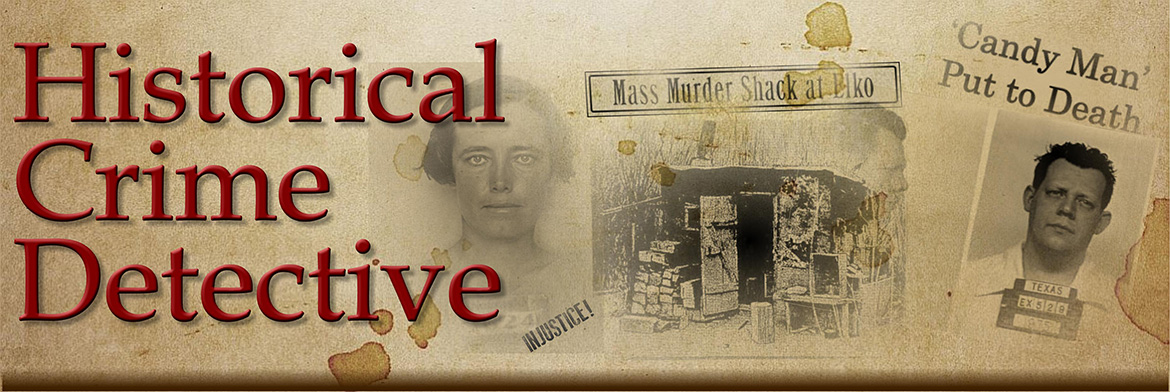The Murder of George Hill for a Worthless Cluster of Imitation Diamonds, 18
Story by Thomas Duke, 1910
“Celebrated Criminal Cases of America”
Part I: San Francisco Cases
In 1865 there resided in San Francisco a young man named George Hill, who had inherited a comfortable fortune, which he had almost entirely dissipated in the gambling games. He was a flashy dresser and constantly wore a scarf pin, said to contain a cluster of diamonds valued at $1,500.
Hill had a room in the Mansion House, on Dupont, near Sacramento Street, and on February 15, 1865, he disappeared. Being of a somewhat wild and roving disposition, no significance was attached to this, either by his landlady or associates.
Some weeks after his disappearance, a gardener named Mr. McGloin was walking through the sand out near his home in San Souci Valley, which is now better designated as the vicinity of Fulton and Baker Streets. A dog he had with him began pulling and tugging at a piece of hay rope, which appeared to be securely fastened to something buried under the sand.
Curiosity prompted Mr. McGloin to investigate, and to his horror he found that the rope was tied around the badly decomposed body of a man. He immediately informed the police of his discovery and the body was brought into town for identification. There was a hole in the side of the head made by some blunt instrument which had evidently caused his death. All valuables had been removed from the body.
Owing to the advanced state of decomposition, it was very difficult to identify the body and the authorities were about to bury the remains when a newspaper reporter who knew Hill well, identified the body.
The police then proceeded to Hill’s room, and the landlady stated that the day after his disappearance, a young man whom she described accurately had come to her house and stated that Hill was about to go to Contra Costa County to procure some money, but that he had met with an accident.
The stranger produced a shirt which had some blood on it and stated that Hill had instructed him to exchange it for a clean one. He was admitted to Hill’s room and, after putting the bloody shirt in the trunk and removing some other articles, he departed, but returned shortly afterward to regain possession of the shirt. The landlady’s suspicions becoming aroused she refused to admit him to Hill’s room.
One of the officers who heard the landlady describe this man recalled that a man then in custody on a charge of forgery answered that description perfectly. Upon being brought before the landlady he was positively identified as the man she referred to and it was learned that his name was Thomas Byrnes, a butcher by trade and the son of the keeper of a roadhouse near Calvary Cemetery.
Mr. McGloin, who discovered Hill’s body, was a warm friend of the family of the murderer.
It was ascertained that on the evening of February 15, 1865, Hill procured a two-horse buggy from Wright & Roden’s livery stable on Kearny Street, near Pine, and in company with Byrnes started for the Cliff House.
About midnight the horses returned alone to the stable, causing the stable-keeper to conclude that there had been a runaway and that the horses had broken away from the vehicle. After a while Byrnes came in and stated that they had met with an accident and that his partner being injured, had sent him for another team.
Before starting away with his second rig, Byrnes asked for a shovel, stating that he wanted to dig the wheels of the other buggy out of the sand. It was observed by the stable man that Byrnes threw a piece of hay-rope into the buggy.
When Hill and Byrnes started the first time, Byrnes insisted on taking a monkey-wrench along, stating that it might be needed.
When they arrived at a spot near where the body was found, Brynes crushed Hill’s skull with the monkey-wrench, the end of which fitted into the wound perfectly. He then cut the harness and scared the horses away, to make it appear that Hill met his death in a runaway accident. He reconsidered, however, and decided that the runaway would not account for the loss of Hill’s property, so the idea of burying the body came to his mind. The rope was used to drag it into the sand, and of course the shovel was used to dig the grave.
It was afterwards learned that Byrnes attempted to pawn Hill’s jewelry and was greatly chagrined to learn that “diamonds” which he thought were worth nearly two thousand dollars, were in reality worth less than three dollars.
Byrnes was found guilty of murder and after a futile appeal to the Supreme Court was executed on September 3, 1866.
—###—


